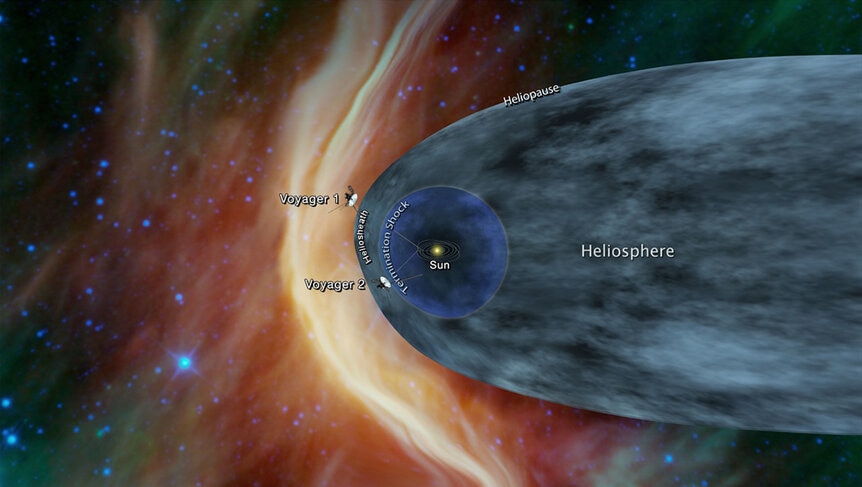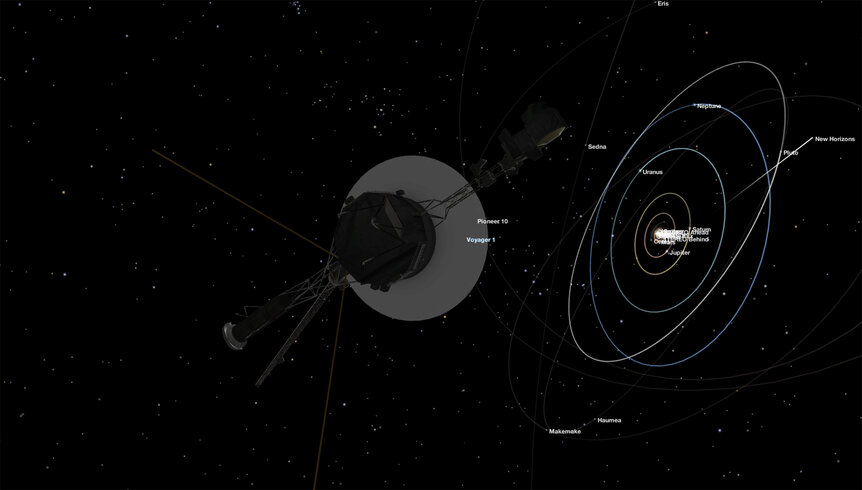Create a free profile to get unlimited access to exclusive videos, sweepstakes, and more!
The Life and Eventual Death of Voyager 1 and 2
Voyager 1 and 2 have been exploring space for 46 years, how much longer do they have?

SYFY’s The Ark (streaming now on Peacock!) imagines a future, about a century from now, in which humans are travelling to another star system for the first time. When and if that actually happens in real life, we’ll have the benefit of having our interstellar course charted, at least in part, by the uncrewed spacecraft that went before us. Key among them: Voyager 1 and 2. Those little mechanical masterminds have been cutting a path through space for nearly half a century and they’re still going strong. They might even get to another star system one day, a few tens of thousands of years from now.
When Were the Voyager Spacecraft Launched?
Voyager 1 and 2 are twin spacecraft launched from Cape Canaveral a few weeks apart in 1977. Contrary to their numerical order, Voyager 2 launched first on August 20, 1977. Voyager 1 followed a couple weeks later on September 5.
RELATED: NASA’s Racing Against the Clock to Keep Voyager Alive in Interstellar Space
The collective Voyager mission was originally planned for five years, with the objective to study Jupiter and Saturn close up. Because of an infrequent planetary lineup that occurs roughly every 175 years, it was possible for the Voyager craft to visit all four of the outer planets along a single path, using one planet’s gravity to bend their trajectory and get a boost to the next destination. Scientists, however, weren’t sure the Voyager craft would survive that long. They couldn’t have been more wrong.
After they finished up at Jupiter and Saturn, engineers and scientists at NASA sent them onward to Uranus and Pluto. On their way out of the solar system, the Voyager probes explored all of the outer planets save Pluto (which was still a planet at the time) and a few dozen moons, returning a view of the outer solar system like none we had ever seen before.
While both Voyagers started out along the same trajectory, they ended up flying off in opposite directions. After their final planetary observations, Voyager 1 shot northward about 35 degrees above the ecliptic plane of the solar system. Voyager 2, by contrast, shot southward about 48 degrees. Based on their current trajectory, each of them will get to within about 1.7 light-years of another star in about 40,000 years, give or take.
What Powers the Voyager Spacecraft?
Most of the spacecraft hanging out in the local neighborhood rely on vast solar arrays to get energy from the Sun. The Voyager craft, however, were headed for the celestial ‘burbs and couldn’t depend on solar energy.
Instead, they were both equipped with a radioisotope thermoelectric generator (RTG). That’s the thing Mark Watney (Matt Damon) dug up and used to heat up his rover in The Martian. That’s not recommended unless and until you are stranded alone on a deserted planet.
RTGs derive energy from the chemical decomposition of its radioactive fuel. Inside each of the RTGs are pellets of plutonium-238. As the fuel decays, it releases energy which strikes the interior and generates heat. That heat is then converted into energy the spacecraft can use to power its instruments. While this is more reliable than solar energy in deep space, it does have its own limitations, namely a consistent loss of power over time.
How Long Will the Voyager Spacecraft Last?
Voyager had a planned mission duration of only five years, and it’s expanded that by nearly a factor of ten. Now, nearly 50 years after launch, they’re still operational and still racing out of the solar system at a rate of about 500 million kilometers (300 million miles) per year.
All things being equal, Voyager 1 and 2 would probably happily continue operating forever, but they’ll eventually run out of fuel. The plutonium inside their RTGs has a half-life of about 88 years. You probably remember from high school chemistry class that half-life is the time it takes for half of any element to decay away.
RELATED: Voyager 1 is now rocking out to some sweet space tunes further away than ever
Forty-six years (the amount of time Voyager 1 and 2 have been whizzing through space) isn’t 88 years, but it is long enough that a substantial portion of their fuel has vanished into the chemical ether, as it were. Less plutonium means less heat, and less heat means less energy. Both Voyager craft are experiencing a power decline of about 4 watts per year.
In response, engineers at NASA have strategically turned off instruments and systems to reduce the load, prioritizing the instruments most likely to send back useful data about interstellar space. In 2019, the team at NASA turned off the instrument heaters to conserve energy and they allowed Voyager 2 to dip into reserve power in early 2023, moves that should extend the spacecraft’s operational life.
At present, NASA is hoping to extend their mission beyond their 50th birthdays and they could potentially send back signals until as late as 2036. After that, they’ll likely be too far away to link up with the Deep Space Network and get signals back to us.
If they ever do reach another star, maybe they’ll receive a hero’s welcome from the future humans living there. They deserve no less.
Catch the complete first season of The Ark, streaming now on Peacock!

































